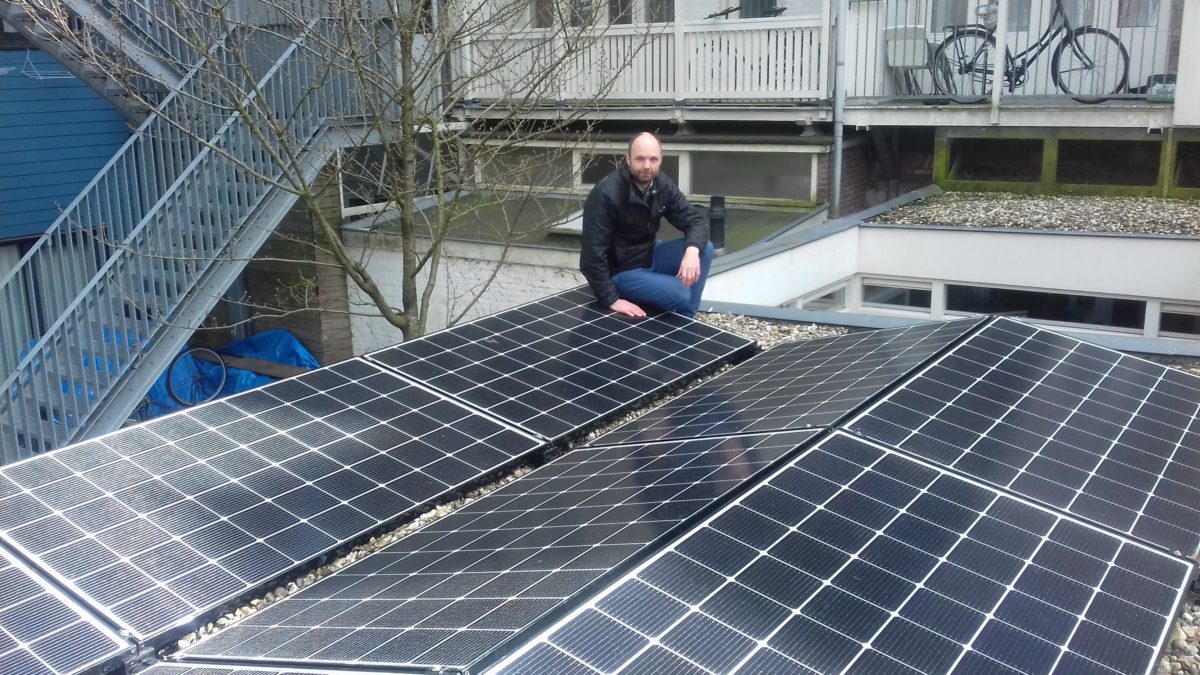Dutch citizens and homeowners seem not to have been discouraged by the challenges ahead for the country’s energy transition, because the number of residential rooftop PV projects developed and installed under the country’s net metering scheme has risen tremendously over the past few years. Sometimes, however – particularly atop the peculiar rooftops of a city such as Amsterdam in which the historical buildings in the center represent one of its most valuable assets – the lack of viable space seems to pose an insurmountable challenge for the installation of a PV array, even of the smallest kind.
But not all homeowners in Amsterdam are being deterred from adopting solar power. One proud Dutchman has decided to install a PV system using solar modules provided by South Korean electronics group LG, and connected in combination with the Huawei FusionHome Smart Energy Center (inverter).
The roof of this gentleman’s apartment, which consists of a small standalone building located in the center of a courtyard surrounded by much higher apartment buildings, presented a serious problem regarding shadowing during certain hours of the day, as well as a few issues for the project’s logistics.
However, an ingenious solution was developed, in order to ensure that the installation process was in fact quite simple.
“When we installed the inverter, the AC part, the connector, was pre-installed by the electrical company, so when the box with the Huawei inverter arrived, I could just mount it on the wall myself, and simply plug in the connector. It was installed in only five minutes,” explains the homeowner.
In addition to saving on the installation costs, the quick deployment of Huawei’s inverter on the wall in the apartment’s storage room also saved time for the completion of the whole installation of the PV panel array, which all in all took around eight hours to complete. “The solar modules, however, had to be installed by an authorized installer, as required by the Netherlands’ current
regulation,” he adds. “Energy storage may also be a part of the solution,” the homeowner further explains. The inverter solution has
already been designed to enable the connection with a storage system. Together with Korean battery provider LG Chem, Huawei is planning to develop new combined offers.
Although the financial side remains challenging, prices are falling – and this in markets where retail energy prices are higher than in Amsterdam, such as Australia. And in off-grid market segments, combined solar+storage solutions may be offered more easily, and are seeing more widespread uptake from consumers.As for the aforementioned shading issues, the homeowner in Amsterdam chose to install Huawei’s optional power optimizers on each of nine solar modules that compose the array. Without these optimizers, he claims, the power yield could be around 10% lower. “With optimizers, there are a lot of custom-made solutions, while costs increase only relatively with this option, because each optimizer costs around €40,” he says. The team of installers that designed the project estimated that it will be able to achieve a return on the initial investment in 8-10 years. “Without optimizers this could have been considerably longer,” he asserts.
The Huawei platform utilized in this installation allows the homeowner to see all of the data related to power production in real time, placed securely on a cloud platform. “You can see all that is happening with energy production just with your mobile phone,” he says. “If you store these data in the cloud, it also becomes possible to share them with different resources.”
In order to check what is going on with the PV system, the homeowner is using a specific app. “It is very easy to utilize: You just log into the platform, and it works immediately. “And you can see every minute of the day what is happening with your production and detect possible issues,” he continues.
All in all, the Huawei FusionHome Smart Energy Center solution, conceived for the households of the future where all appliances and electrical needs are expected to be integrated and monitored through smart and centralized control, has shown that it offers a practical solution for a digitized energy future – even when installed in even the most traditional type of dwelling in downtown Amsterdam.
This article is taken from pv magazine‘s 2018 special edition, developed in partnership with Huawei. Read the full special edition here.
This content is protected by copyright and may not be reused. If you want to cooperate with us and would like to reuse some of our content, please contact: editors@pv-magazine.com.



By submitting this form you agree to pv magazine using your data for the purposes of publishing your comment.
Your personal data will only be disclosed or otherwise transmitted to third parties for the purposes of spam filtering or if this is necessary for technical maintenance of the website. Any other transfer to third parties will not take place unless this is justified on the basis of applicable data protection regulations or if pv magazine is legally obliged to do so.
You may revoke this consent at any time with effect for the future, in which case your personal data will be deleted immediately. Otherwise, your data will be deleted if pv magazine has processed your request or the purpose of data storage is fulfilled.
Further information on data privacy can be found in our Data Protection Policy.